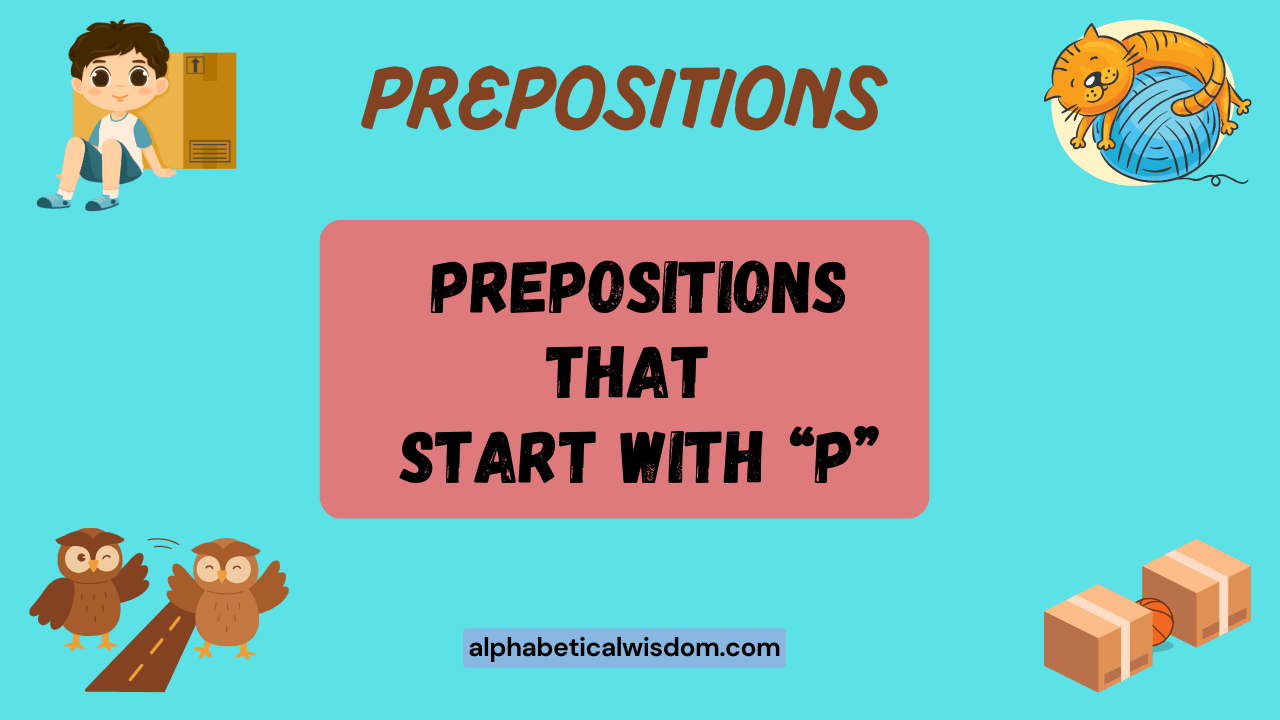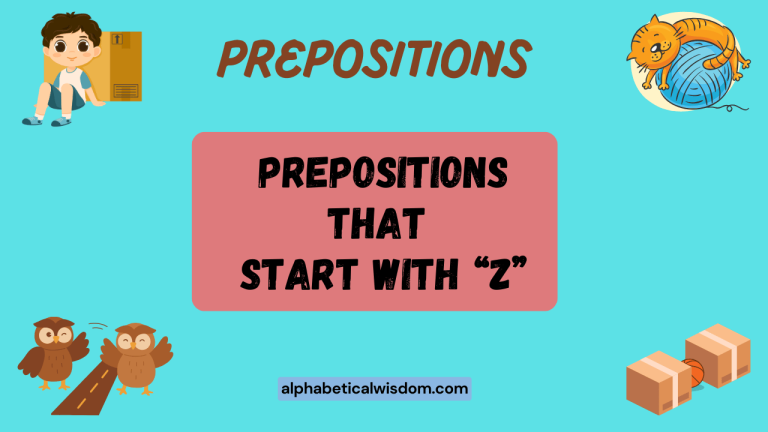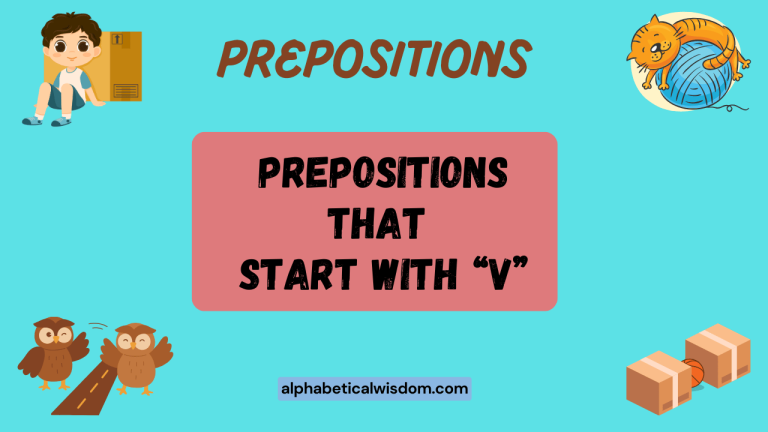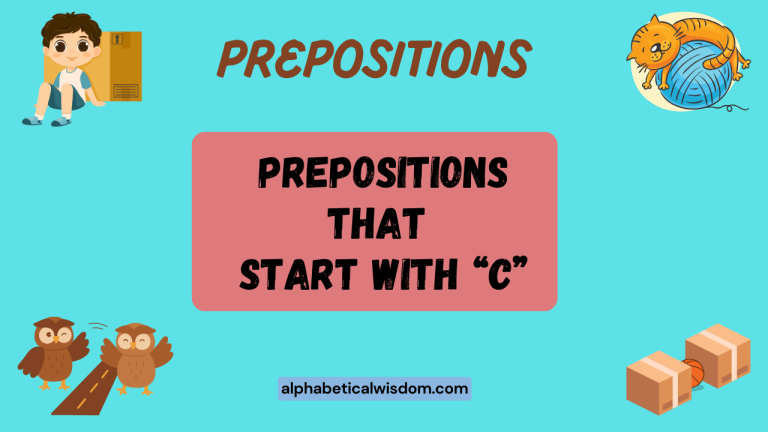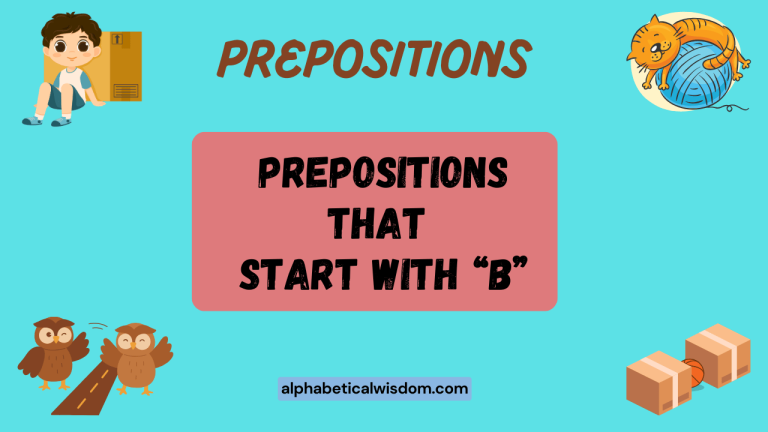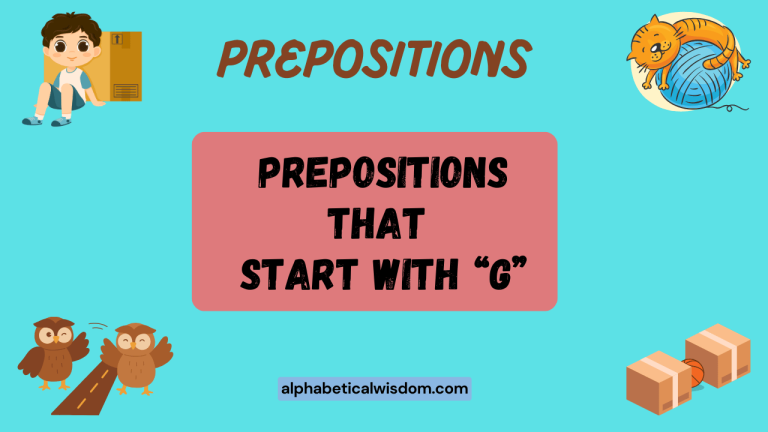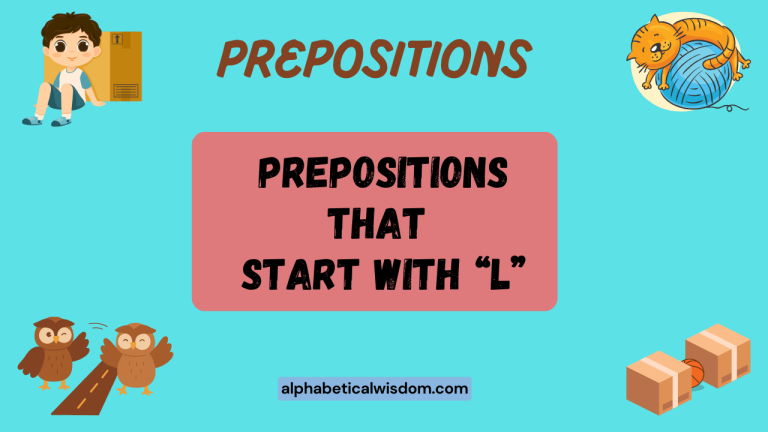Prepositions Starting with P: A Comprehensive Guide
Mastering prepositions is crucial for clear and accurate English communication. Prepositions, though small words, play a significant role in connecting nouns, pronouns, and phrases to other parts of a sentence.
This guide focuses specifically on prepositions starting with the letter “P,” providing a detailed exploration of their definitions, usage, and common pitfalls. Understanding these prepositions will enhance your writing and speaking skills, making your English more precise and fluent.
This article is suitable for English learners of all levels, from beginners to advanced speakers, as well as teachers looking for comprehensive explanations and examples.
Table of Contents
- Introduction
- Definition of Prepositions
- Structural Breakdown
- Types and Categories
- Examples of Prepositions Starting with P
- Usage Rules
- Common Mistakes
- Practice Exercises
- Advanced Topics
- Frequently Asked Questions (FAQ)
- Conclusion
Definition of Prepositions
A preposition is a word that connects a noun, pronoun, or noun phrase to other words in a sentence. It indicates the relationship between the noun or pronoun and other elements, often expressing location, direction, time, or manner.
Prepositions typically come before the noun or pronoun they govern, which is why they are called “pre-positions.” Understanding their function is key to building grammatically correct and meaningful sentences.
Prepositions can be classified based on their structure and function. They are essential for creating clear and concise sentences, as they provide context and specify relationships between different parts of the sentence.
Without prepositions, it would be difficult to express spatial, temporal, or logical connections between ideas.
Structural Breakdown
The basic structure involving a preposition includes the preposition itself followed by its object, which is typically a noun, pronoun, or noun phrase. This combination is known as a prepositional phrase. The prepositional phrase functions as an adjective or adverb, modifying other words in the sentence.
For example, in the sentence “The book is on the table,” “on” is the preposition, and “the table” is the object of the preposition. The entire phrase “on the table” acts as an adverbial phrase, modifying the verb “is” by indicating the location of the book. Recognizing this structure helps in correctly identifying and using prepositions.
Types and Categories
Prepositions can be categorized into three main types based on their form and complexity:
Simple Prepositions
Simple prepositions consist of a single word. Common examples include at, in, on, to, from, with, by, for, of, and those starting with “P” such as past, per, plus. These prepositions are fundamental and frequently used in everyday language.
Compound Prepositions
Compound prepositions, also known as complex prepositions, are formed by combining two or more words, often including a simple preposition. Examples include according to, because of, in front of, in spite of, on behalf of. These prepositions provide more specific and nuanced relationships compared to simple prepositions.
Phrasal Prepositions
Phrasal prepositions consist of a preposition combined with other words to form a distinct phrase that functions as a single preposition. Examples include in addition to, with regard to, due to. These phrases often have a fixed meaning and are used to express complex relationships between elements in a sentence.
Examples of Prepositions Starting with P
This section provides detailed examples of prepositions starting with the letter “P,” illustrating their various usages in sentences. Each preposition is accompanied by multiple examples to demonstrate its versatility and common contexts.
Examples with “Past”
The preposition “past” indicates movement beyond a specific point or a time after a particular moment. It can also refer to previous events or experiences.
Here are some examples:
The following table provides examples using the preposition “past”:
| Sentence | Explanation |
|---|---|
| He walked past the library. | Indicates movement beyond the library. |
| It’s half past five. | Indicates the time is thirty minutes after five. |
| She has a lot of experience in the past. | Refers to previous experiences. |
| We drove past several small towns on our way to the beach. | Indicates movement beyond those towns. |
| The deadline is long past. | Indicates the deadline has already passed. |
| Don’t dwell on the mistakes of the past. | Refers to events that have already happened. |
| The runners sprinted past the finish line. | Indicates movement beyond the finish line. |
| The train sped past the station without stopping. | Indicates the train moved beyond the station. |
| He reminisced about his life in the past. | Refers to a period in the past. |
| She glanced past him and out the window. | Indicates her gaze moved beyond him. |
| The storm has now past leaving destruction behind. | Indicates the storm has moved on. |
| He tried to forget the troubles of the past. | Refers to previous difficulties. |
| They lived in a small village past the mountains. | Indicates the village is located beyond the mountains. |
| The memories of the past often haunted him. | Refers to events that occurred previously. |
| She quickly moved past the awkward moment. | Indicates she moved beyond the situation. |
| We need to learn from the past to improve the future. | Refers to previous experiences and events. |
| The car zoomed past us on the highway. | Indicates movement beyond our location. |
| The danger is now past. | Indicates the danger has ended. |
| He looked past the flaws and saw her potential. | Indicates he disregarded the flaws. |
| She walked slowly past the old house. | Indicates movement beyond the house. |
| The era is past. | Indicates the era has ended. |
| The parade marched past the reviewing stand. | Indicates movement beyond the stand. |
| He waved as he drove past. | Indicates movement beyond a certain point. |
Examples with “Pending”
The preposition “pending” means “waiting to be decided” or “during the time that something is waiting to happen.” It indicates a state of suspension or anticipation. While less common as a pure preposition, it’s often used in contexts where something is unresolved.
The following table provides examples using the preposition “pending”:
| Sentence | Explanation |
|---|---|
| The decision is pending approval. | Indicates the decision is waiting for approval. |
| Flights are delayed pending further notice. | Indicates flights are delayed until further information is available. |
| The application is pending review. | Indicates the application is waiting to be reviewed. |
| His job offer is pending a background check. | Indicates the offer is contingent on a background check. |
| The legislation is pending in Congress. | Indicates the legislation is awaiting action in Congress. |
| The game is postponed pending better weather conditions. | Indicates the game is delayed until the weather improves. |
| The investigation is pending further evidence. | Indicates the investigation is waiting for more evidence. |
| Her promotion is pending the completion of her training. | Indicates the promotion is conditional on finishing training. |
| The contract is pending final negotiations. | Indicates the contract is waiting for negotiations to conclude. |
| The lawsuit is pending a court hearing. | Indicates the lawsuit is waiting for a hearing. |
| The project is on hold pending funding. | Indicates the project is waiting for money. |
| All sales are pending verification. | Indicates sales are waiting to be verified. |
| The construction is paused pending environmental approval. | Indicates construction is waiting for approval. |
| The agreement is pending signature. | Indicates the agreement is waiting for a signature. |
| The account is suspended pending investigation. | Indicates the account is waiting for investigation. |
| The shipment is delayed pending customs clearance. | Indicates the shipment is waiting for clearance. |
| The transfer is pending confirmation. | Indicates the transfer is waiting for confirmation. |
| The merger is pending regulatory review. | Indicates the merger is waiting for review. |
| The decision on the appeal is pending. | Indicates the decision is waiting. |
| Further developments are pending. | Indicates new developments are waiting. |
Examples with “Per”
The preposition “per” means “for each” or “by means of.” It is often used to express rates, proportions, or methods. It’s commonly found in technical and formal contexts.
The following table provides examples using the preposition “per”:
| Sentence | Explanation |
|---|---|
| The speed limit is 60 miles per hour. | Indicates speed for each hour. |
| The cost is $10 per person. | Indicates the cost for each person. |
| They are paid per project. | Indicates payment for each project. |
| The dosage is one tablet per day. | Indicates the dosage for each day. |
| The yield is 10 tons per acre. | Indicates the yield for each acre. |
| The interest rate is 5% per annum. | Indicates the rate for each year. |
| The consumption is 10 liters per 100 kilometers. | Indicates consumption for each 100 kilometers. |
| We need two representatives per region. | Indicates the number of representatives for each region. |
| The fee is calculated per transaction. | Indicates the fee for each transaction. |
| The data is analyzed per capita. | Indicates analysis for each person. |
| The tax is assessed per property. | Indicates the tax for each property. |
| The rent is $1200 per month. | Indicates the rent for each month. |
| We charge per word for translation services. | Indicates the charge for each word. |
| The electricity bill is calculated per kilowatt-hour. | Indicates the bill for each kilowatt-hour. |
| The subscription costs $20 per quarter. | Indicates the cost for each quarter. |
| The seating arrangement is two chairs per table. | Indicates the number of chairs for each table. |
| The company measures productivity per employee. | Indicates measurement for each employee. |
| The fine is $50 per violation. | Indicates the fine for each violation. |
| The allocation is 10 shares per investor. | Indicates the amount for each investor. |
| The commission is paid per sale. | Indicates the payment for each sale. |
Examples with “Plus”
The preposition “plus” means “in addition to.” It indicates that something is being added or included. It is often used informally.
The following table provides examples using the preposition “plus”:
| Sentence | Explanation |
|---|---|
| Two plus two equals four. | Indicates addition. |
| She brought her sister, plus a friend. | Indicates an addition to the group. |
| The price is $20, plus tax. | Indicates tax is added to the price. |
| He has a car, plus a motorcycle. | Indicates he possesses both items. |
| We need more chairs, plus some extra tables. | Indicates an additional need. |
| The job requires experience, plus a strong work ethic. | Indicates additional requirements. |
| She speaks English, plus French. | Indicates additional language skills. |
| The meal includes soup, plus a salad. | Indicates an additional item in the meal. |
| He received a salary, plus bonuses. | Indicates additional compensation. |
| The team has skill, plus determination. | Indicates additional qualities of the team. |
| The course covers history, plus geography. | Indicates additional subjects. |
| The package contains a shirt, plus a pair of pants. | Indicates additional items in the package. |
| She has talent, plus dedication. | Indicates additional qualities she possesses. |
| The event needs music, plus decorations. | Indicates additional requirements for the event. |
| The apartment has a balcony, plus a garden. | Indicates additional features of the apartment. |
| The project requires time, plus resources. | Indicates additional needs for the project. |
| He brought snacks, plus drinks. | Indicates additional items he brought. |
| The car has air conditioning, plus heated seats. | Indicates additional features of the car. |
| The plan includes training, plus support. | Indicates additional components of the plan. |
| The offer includes a discount, plus free shipping. | Indicates additional benefits of the offer. |
Examples with “Prior”
The preposition “prior” means “before” or “preceding.” It indicates that something happens or exists earlier in time. It is more formal than “before.”
The following table provides examples using the preposition “prior”:
| Sentence | Explanation |
|---|---|
| Prior to the meeting, please review the agenda. | Indicates an action before the meeting. |
| We need prior approval before proceeding. | Indicates the need for approval beforehand. |
| She had no prior experience in this field. | Indicates a lack of previous experience. |
| They conducted a prior investigation. | Indicates an investigation that occurred earlier. |
| He made a prior commitment to another event. | Indicates a commitment made earlier. |
| Prior to the exam, students should study diligently. | Indicates an action before the exam. |
| Please submit your application prior to the deadline. | Indicates submission should be before the deadline. |
| The company had prior knowledge of the issue. | Indicates earlier awareness of the problem. |
| We require prior notification of any changes. | Indicates the need for advance notice. |
| She had a prior engagement and couldn’t attend. | Indicates a previous commitment. |
| Prior to the invention of the printing press, books were handwritten. | Indicates a time before the invention. |
| The building had a prior owner. | Indicates a previous owner. |
| We need to resolve this prior to the next phase. | Indicates resolution before the next phase. |
| The research built on prior studies. | Indicates earlier research. |
| He checked his prior appointments. | Indicates previous appointments. |
| Prior to the flight, passengers must go through security. | Indicates an action before the flight. |
| The law was based on prior legislation. | Indicates earlier legislation. |
| They reviewed prior performance evaluations. | Indicates previous evaluations. |
| She consulted prior medical records. | Indicates previous records. |
| The event was planned prior to the announcement. | Indicates planning before the announcement. |
Usage Rules
Using prepositions correctly is essential for clear communication. Here are some key rules to follow when using prepositions starting with “P”:
Rule 1: Placement
Prepositions typically precede the noun, pronoun, or noun phrase they govern. This order helps establish the relationship between the preposition and its object.
However, there are exceptions, such as in questions or relative clauses.
Correct: He walked past the store.
Correct: What are you looking at?
Rule 2: Object of the Preposition
The object of a preposition must be a noun, pronoun, or noun phrase. It cannot be a verb in its base form.
If you need to use a verb, it should be in the gerund form (i.e., the -ing form).
Correct: He is good at swimming.
Incorrect: He is good at swim.
Rule 3: Avoiding Stranded Prepositions
A stranded preposition occurs when a preposition is left at the end of a sentence, typically in informal English. While sometimes acceptable, it’s often considered less formal and may be avoided in academic or professional writing.
Informal: What are you looking at?
Formal: At what are you looking?
Rule 4: Formal vs. Informal Usage
Some prepositions, like “plus” and “per,” have different levels of formality. “Plus” is often used in informal contexts, while “per” is more common in formal or technical writing.
Consider your audience and the context when choosing prepositions.
Informal: She brought her sister, plus a friend.
Formal: The cost is $10 per person.
Common Mistakes
Even experienced English speakers sometimes make mistakes with prepositions. Here are some common errors to watch out for:
| Incorrect | Correct | Explanation |
|---|---|---|
| He walked pass the store. | He walked past the store. | “Pass” is a verb; “past” is the preposition. |
| The decision is pending of approval. | The decision is pending approval. | “Pending” does not require “of” after it. |
| The cost is $10 in person. | The cost is $10 per person. | “Per” is used to express “for each.” |
| Two plus to equals four. | Two plus two equals four. | The correct word is “two” not “to”. |
| Prior than the meeting… | Prior to the meeting… | “Prior” is used with “to,” not “than.” |
Practice Exercises
Test your understanding of prepositions starting with “P” with these exercises:
Exercise 1: Fill in the Blanks
Fill in the blanks with the correct preposition (past, pending, per, plus, prior):
| Question | Answer |
|---|---|
| 1. He walked ______ the park. | past |
| 2. The decision is ______ review. | pending |
| 3. The cost is $5 ______ item. | per |
| 4. She has a dog, ______ a cat. | plus |
| 5. ______ to the event, please RSVP. | Prior |
| 6. The time is half ______ six. | past |
| 7. The application is ______ approval. | pending |
| 8. The salary is $50,000 ______ year. | per |
| 9. He has experience, ______ a degree. | plus |
| 10. ______ to his arrival, we prepared the room. | Prior |
Exercise 2: Error Correction
Identify and correct the errors in the following sentences:
| Incorrect Sentence | Correct Sentence |
|---|---|
| 1. He ran pass me. | He ran past me. |
| 2. The case is pending of a decision. | The case is pending a decision. |
| 3. The fee is $20 to person. | The fee is $20 per person. |
| 4. She brought a book, plus to magazines. | She brought a book, plus two magazines. |
| 5. Prior than the deadline, submit your work. | Prior to the deadline, submit your work. |
| 6. The danger is pass now. | The danger is past now. |
| 7. The game is pending of rain. | The game is pending rain. |
| 8. We get paid for hour. | We get paid per hour. |
| 9. He has a bike, plus also a scooter. | He has a bike, plus a scooter. |
| 10. Prior of the meeting, read the document. | Prior to the meeting, read the document. |
Exercise 3: Sentence Construction
Create sentences using the following prepositions:
| Preposition | Example Sentence |
|---|---|
| past | The train sped past the station. |
| pending | The contract is pending final approval. |
| per | The cost is $10 per day. |
| plus | She speaks English, plus Spanish. |
| prior | Prior to the event, register online. |
| past | He walked past the old oak tree. |
| pending | The sale is pending verification. |
| per | They charge per word for editing. |
| plus | He has a car, plus a truck. |
| prior | Prior to his arrival, the room was cleaned. |
Advanced Topics
For advanced learners, understanding the nuances of prepositions in more complex grammatical structures is essential. Here are some advanced topics to explore:
Prepositional Verbs
Prepositional verbs are verbs that are followed by a preposition, which together create a new meaning. These combinations act as a single unit and cannot be separated.
For example, “look after” means “take care of.”
Examples: look after, give up, get over.
Prepositional Phrases as Adjectives and Adverbs
Prepositional phrases can function as adjectives or adverbs, modifying nouns or verbs, respectively. As adjectives, they describe nouns; as adverbs, they describe verbs, adjectives, or other adverbs.
Adjective: The book on the table is mine.
Adverb: He walked with confidence.
Frequently Asked Questions (FAQ)
Here are some frequently asked questions about prepositions starting with “P”:
- What is the difference between “past” and “passed”?
“Past” is a preposition, adjective, or noun indicating time or movement beyond a point. “Passed” is the past tense of the verb “to pass,” meaning to move beyond or to succeed.
- How is “pending” used in a sentence?
“Pending” typically means “waiting to be decided” or “during the time that something is waiting to happen.” It often describes a state of suspension or anticipation. For example, “The application is pending review” means the application is waiting to be reviewed.
- When should I use “per” instead of “for each”?
“Per” is generally used in formal or technical contexts to express rates, proportions, or methods. “For each” is more informal and can be used in everyday conversation. “Per” is often preferred in scientific or business writing.
- Is it correct to use “plus” in formal writing?
While “plus” is commonly used in informal contexts to mean “in addition to,” it may be considered less formal in academic or professional writing. In formal writing, consider using alternatives like “in addition to,” “moreover,” or “furthermore.”
- What is the difference between “prior to” and “before”?
“Prior to” and “before” both indicate something happening earlier in time, but “prior to” is more formal. Use “prior to” in formal writing and “before” in more casual contexts.
- Can a prepositional phrase start a sentence?
Yes, a prepositional phrase can start a sentence. When it does, it usually functions as an adverbial modifier, providing context or setting the scene. For example: “Prior to the meeting, please review the agenda.”
- What part of speech usually follows a preposition?
A preposition is usually followed by a noun, pronoun, or noun phrase, which serves as the object of the preposition. This combination forms a prepositional phrase.
- Are there any exceptions to the rule that prepositions come before their objects?
Yes, there are exceptions. In questions using “who” or “what,” the preposition may come at the end of the sentence. Also, in relative clauses, the preposition can be separated from its object. For example: “Who are you talking to?”
- How can I improve my understanding of prepositions?
To improve your understanding of prepositions, practice reading and writing in English, pay attention to how native speakers use prepositions, and use online resources and grammar guides to study specific rules and examples. Consistent practice and exposure to the language are key.
- Is “pending on” ever correct?
No, “pending on” is generally incorrect. The correct usage is simply “pending,” which already implies that something
is waiting for a resolution or decision.
Conclusion
Understanding and correctly using prepositions starting with the letter “P” is essential for mastering English grammar. By learning the definitions, usage rules, and common mistakes associated with prepositions like “past,” “pending,” “per,” “plus,” and “prior,” you can significantly improve your writing and speaking skills.
Remember to practice regularly and pay attention to how these prepositions are used in various contexts. With consistent effort, you can confidently and accurately incorporate these prepositions into your everyday communication.
